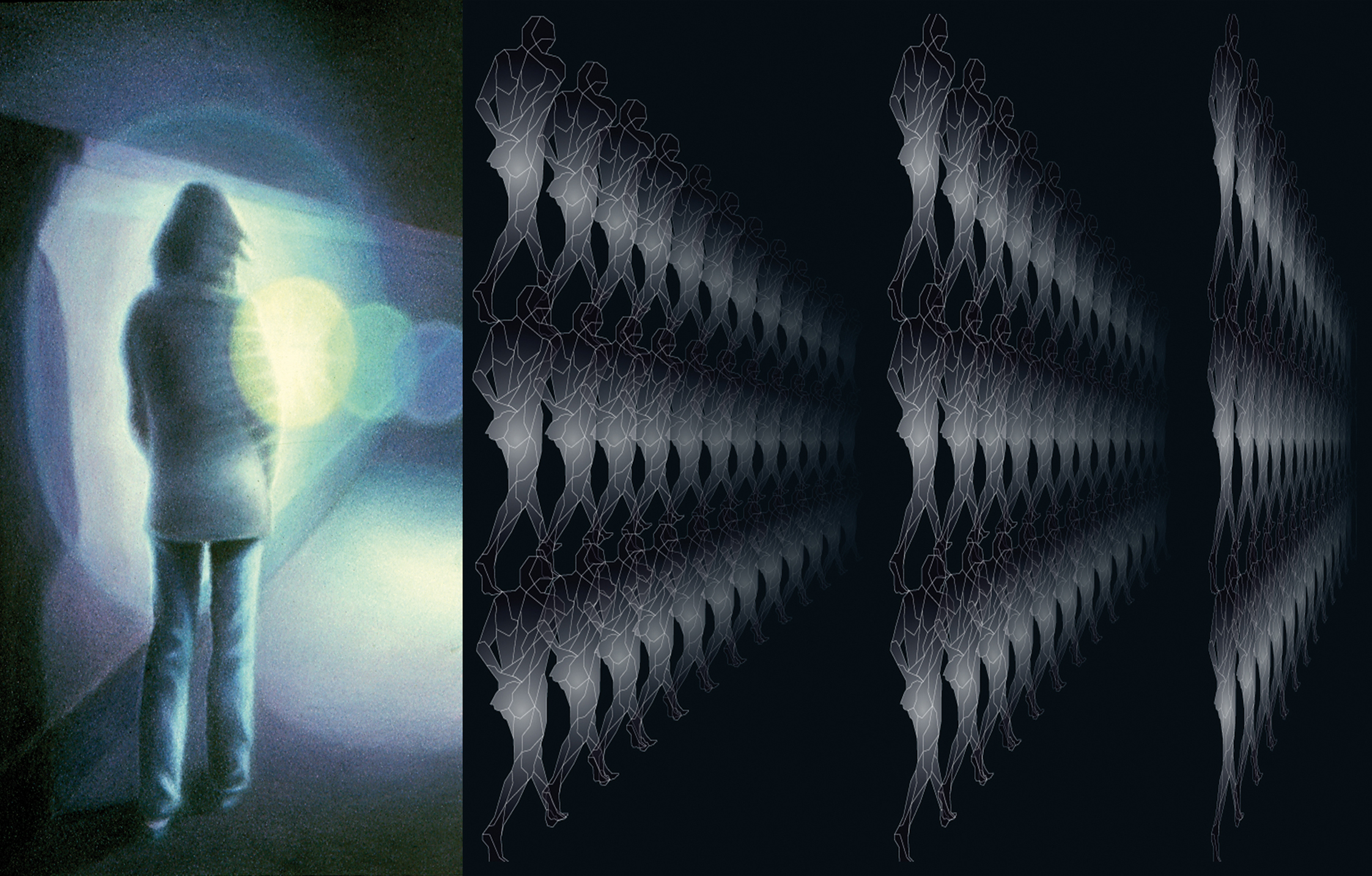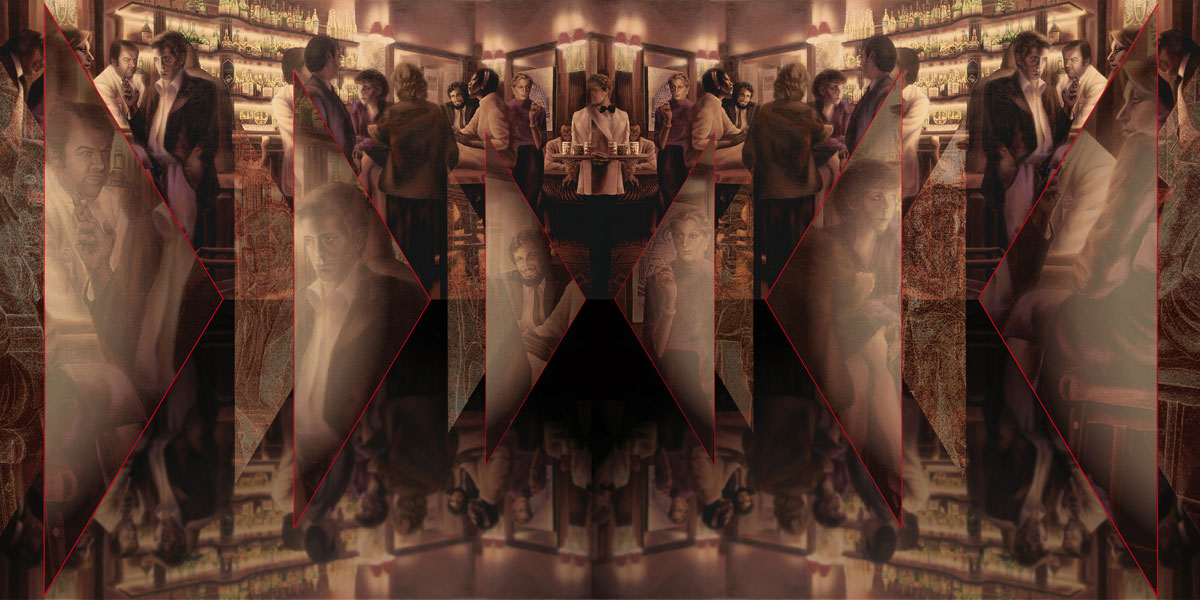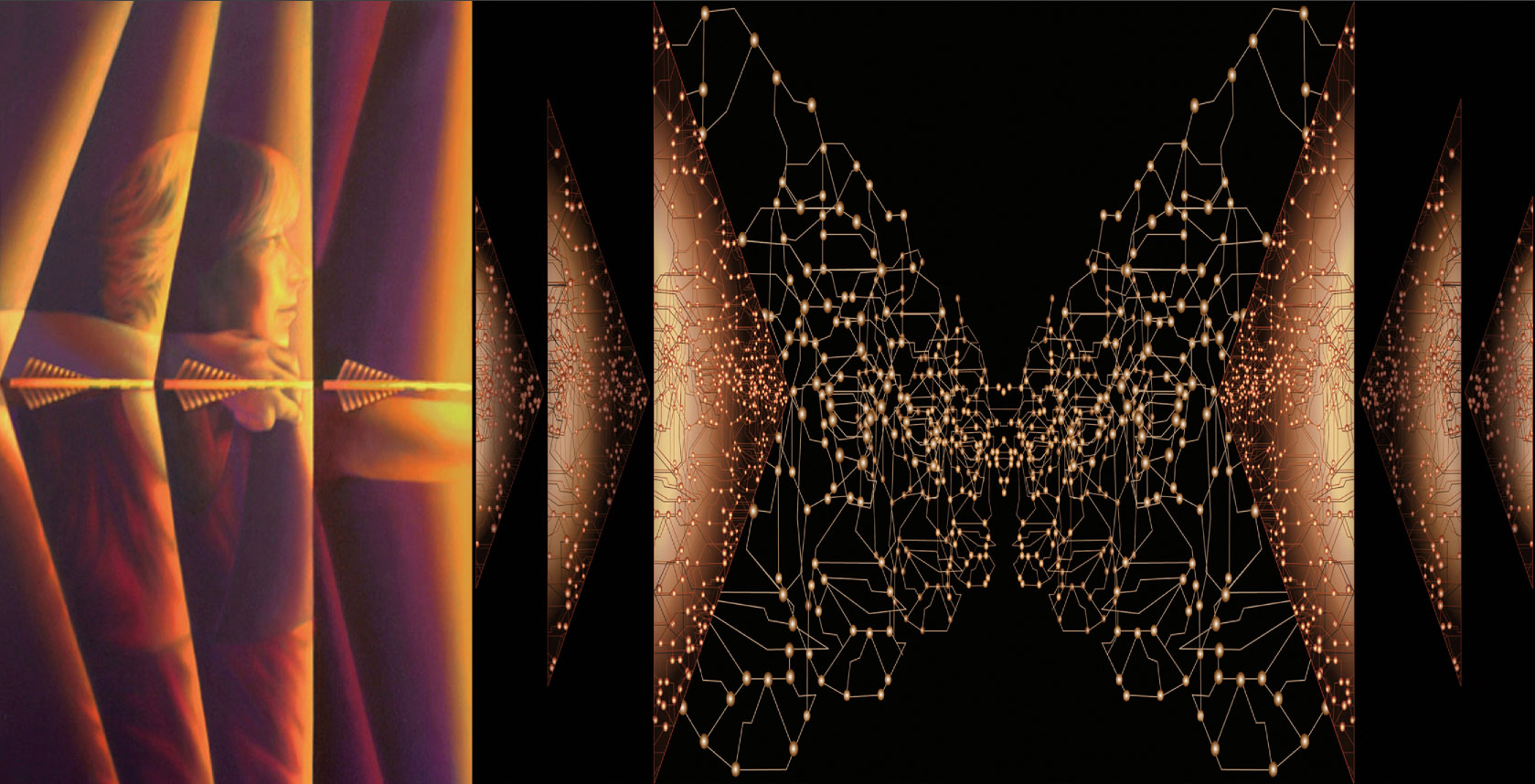LES HYBRIDES

À travers une œuvre qui va de l’hyperréalisme au fractal, Jean Claude Meynard a décliné deux thèmes majeurs : l’identité et le double.
Dès les années 70, avec les séries, Shizophrénie, le Jeu, Corps et Ames, jusqu’à la Matrice de Babel en 2009 où la silhouette humaine se fractalise et se démultiplie, il n’a cessé d’interroger ce « Je » qui est un « Autre ».
Un « Autre Mythique » qu’il explore aujourd’hui avec la figure de Babel – tour de pierres qu’il a transformée avec le fractal, sa géométrie d’exécution, en une architecture d’hommes, réalisant ainsi sa première forme hybride.
C’est sous ce signe de Babel qu’il a justement placé tous ses hybrides pour en signifier l’aspect transgressif. Elever une tour jusqu’au ciel est un défi aux lois humaines ; les hybrides de Meynard sont un défi aux fiches signalitiques de l’œuvre d’art : une date, un titre, une définition, un genre, une influence, une histoire. Meynard bouscule cet appareillage de la connaissance. Déjà il bouscule le temps. En rapprochant ses œuvres d’époques souvent très éloignées, en bannissant les genres, en recomposant l’hyperréalisme avec le fractal, il crée une brisure chronologique. Le temps cesse d’être linéaire, il devient spirale, zigzag, télescopage. Un temps inédit. Inventé. Comme l’espace. En hybridant ses œuvres, Meynard opère un changement d’optique et d’échelle, et l’œuvre nouvelle qu’il met à jour s’organise à l’intérieur d’un cadre absolument imaginaire.
Le parcours de Meynard, qui a porté sur le réel et la figuration de l’homme, a toujours été celui d’un chercheur de formes. Aujourd’hui, avec ses Hybrides, il explore la forme même de son œuvre. Par la combinatoire qu’il a mise au point, il greffe, associe, reformule, recompose ses propres toiles, comme si, en elles-mêmes, elles n’avaient pas tout montré, qu’elles contenaient d’autres possibles, d’autres figures, d’autres sens, d’autres toiles.
En cela, ce travail d’expérimentation qu’il réalise avec ses œuvres est aussi un mode de connaissance. Une toile qu’on penserait depuis longtemps connue, c’est à dire apprivoisée par le regard, une fois hybridée peut se révéler sauvage, méconnaissable.
![]()
Ainsi quand Meynard réalise : « Icône I », hybride de l’Escalier de 1975, avec les Icares de 1995, et un Moucharabieh de 2005, il libère, enrichit, ou renouvelle les œuvres qui composent cet hybride.
Dans une première approche, c’est le motif de la spirale, commun à ces trois œuvres, qui permet leur hybridation. Puis le travail de recréation donne à voir plus et autrement. L’escalier avec son mort énigmatique va au-delà de son référent visuel - cinématographique.
En l’hybridant avec les Icares, Meynard dévoile sa dimension métaphysique, celle de la chute de l’homme. Quant aux Icares qui, par leur envol héroïque, défient la loi humaine, l’Escalier prosaïque leur apporte la dimension profane, la banale condition de l’homme, la chute sans grandeur.
Le Moucharabieh, lui, par son caractère intemporel, spiralé, presque byzantin, greffe les deux toiles d’une marque icônique. Ainsi Meynard, en hybridant ses trois œuvres, en les réinventant, réalise un grand icône sur la condition humaine : un panorama existentiel.
Meynard a toujours travaillé sur la forme - entre hyper réalité et géométrie fractale - il a tracé les figures du réel et de l’homme, et montré qu’une forme était toujours en devenir, en transformation et renouvellement. C’est pourquoi ses hybridations sont possibles, et fulgurantes, parce déjà en germes dans son parcours.
En faisant naître ses hybrides, en faisant de son art, de ses propres toiles, sa matière première et son terrain d’expérimentation, Meynard ouvre un champ de création à la combinatoire illimitée, et au delà, dans ce rapport particulier, dans ce duo qu’il a établi avec son œuvre, il crée un jeu de miroir - peintre et œuvre, qui regarde l’autre ?
Elisabeth Préault, extrait du livre « Babel, la Géométrie des Enigmes »

Throughout works ranging from hyper-realism to fractal depiction, Jean-Claude Meynard has been a vehicle for two major themes: identity and the doppelgänger.
From the 70’s, with the Schizophrenia, Games, Body and Soul series, all the way to the Matrix of Babel in 2009, where the human silhouette is fractured and multiplied, he has ceaselessly pondered this “I” which is an “Other”.
Here’s a “Mythical Other” which he is exploring today with the figure of Babel – a stone tower that he has transformed through his use of fractal geometry, turned into an architecture of Man, producing his first hybrid form.
It is precisely under the sign of Babel that he has put all of his hybrids to convey a transgressive feeling. Raising a tower into the sky defies human laws; Meynard’s hybrids are a defiance of the fact sheets of art works: a date, a title, a definition, a genre, an influence or a history. Meynard upsets this knowledge format. For a start, he upsets time. By juxtaposing his works from often very distant periods, by banning genres and by recomposing hyper-realism with fractal geometry, he creates a time warp. Time is no longer linear, it spirals, zigzags and telescopes. A new time. Invented. Like for space. By hybridizing his works, Meynard forces a change of optics and scale, and the new work that he updates is organized within an absolutely imaginary setting.
Meynard’s trajectory, geared towards reality and the human figure, has always been that of a seeker of shapes. Today, with his Hybrids, he is exploring the very shape of his work. By the combinations he’s perfected, he transplants, associates, reformulates and recomposes his own paintings, as if, by themselves, they had not yet revealed that they contained other possibilities, other figures, other meanings and other paintings.
Thus, this experimental task he’s doing with his works is also a gateway to knowledge. A painting that we thought was long ago understood – or tamed by the gaze – as soon as it’s hybridized – can reveal itself as wild and unrecognizable. So when Meynard paints “Icône 1”, a hybrid of “The Stairs” (1975) with “Icari” (1995) and Mashrabiya (2005), he liberates, enriches or renews the works making up this hybrid.

In a first approach, there’s the spiral motif, common to these three works, which enables their hybridization. Then the task of re-creation appears increasingly and diversely. “The stairs” with its enigmatic cadaver goes beyond its cinematographic visual reference.
By hybridizing it with the Icari, Meynard reveals its metaphysical dimension, that of the Fall of Man. As for the Icari, who, via their heroic flight, defy human law, the stark Stairs provides them with an earthly dimension, the mundane human condition, the inglorious Fall. The Mashrabiya, through its timeless, spiralling and quasi-Byzantine character, implant an iconing imprint to the other two paintings. Thus Meynard, by hybridizing his three works and by reinventing them, produces one large icon for the human condition: an existential panorama.
Meynard has always worked on forms – whether they be in hyper-reality or fractal geometry – he traces figures from reality and from mankind, and shows that a shape has always been in progress, in transformation and renewal. That is why his hybridizations are do-able and striking, since they are already in germination in his artwork trajectory.
By giving birth to his hybrids, by using his art, his own paintings as his raw materials and his field laboratory, Meynard opens the creative path to unlimited combinations and beyond. In this special relationship, this duo he plays with his own works, he is creating mirrored interplay – painting and works, who is staring at whom?
Elisabeth Préault, extrait du livre « Babel, la Géométrie des Enigmes », translated by Richard Prevett